In the dynamic world of digital marketing for 2025, marketers are navigating a complex economic environment marked by persistent inflation, fragile supply chains, and the profound shifts triggered by new trade tariffs. The core challenge is undeniable: as tariffs increase the cost of doing business, companies are forced to scrutinize every expenditure, and marketing budgets are often the first to face cuts.
Table of Contents
The impact of Trump tariffs on digital marketing is no longer a future possibility but a current reality, compelling a strategic pivot away from high-cost advertising toward more resilient, long-term growth channels.
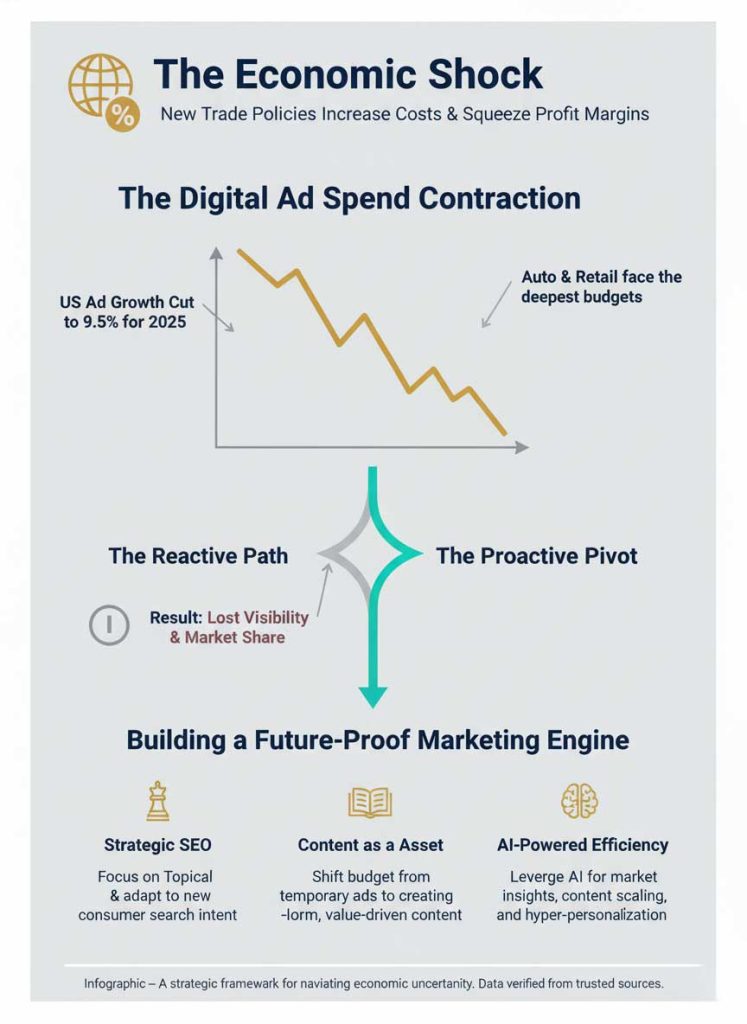
This economic pressure, however, unveils a significant opportunity for brands to build lasting value through a deliberate and sophisticated SEO strategy adaptation. While paid ad budgets may shrink, the brands that reinvest in organic authority, content excellence, and deep customer understanding will emerge stronger. This article is a comprehensive playbook designed to dissect the direct impacts of trade policies on digital ad spend, providing a data-driven framework for adapting your SEO strategy, leveraging AI, and building a marketing ecosystem that not only survives but thrives in this era of economic uncertainty.
The Unseen Connection: How Trade Policies Directly Impact Your Digital Ad Budget
Many marketers view trade policy as a distant macroeconomic issue, disconnected from their daily campaign management. However, the financial ripple effect of tariffs flows directly into ad auction platforms and campaign dashboards, creating a clear trade policy marketing impact that cannot be ignored. Understanding this connection is the first step toward building a resilient strategy.

From Tariffs to Ad Bids: The Financial Ripple Effect
The mechanism is a straightforward chain reaction. When tariffs are imposed on imported goods—like electronic components from China or automotive parts from Europe—the Cost of Goods Sold (COGS) for US businesses rises. This immediately squeezes profit margins, forcing executives to find ways to reduce operational expenses. This macroeconomic influence on marketing is direct and swift.
This pressure often leads to a significant ad budget reduction, as marketing is one of the largest variable expenses for many companies. As budgets shrink, campaign managers must lower their cost-per-acquisition (CPA) targets and reduce their bids in competitive ad auctions. This results in less visibility, lower impression share, and ultimately, fewer conversions from paid channels.
Why Digital Advertising is Often the First Budget to Be Cut
In corporate finance, there’s a critical distinction between investments and expenses. Unfortunately, performance marketing is often viewed as a discretionary, short-term expense that can be dialed up or down like a utility. When profits are under threat, cutting this “expense” seems like a logical first move to protect the bottom line. This is a crucial point in the paid media vs SEO debate.
In contrast, SEO is an investment in a long-term, appreciating digital asset. The content and authority you build today will continue to generate organic traffic and leads for months and years to come, without a direct per-click cost. This fundamental difference is why a strategic pivot from paid ads to SEO is the most powerful defensive and offensive move a brand can make during periods of economic volatility driven by economic policy digital marketing.
Data-Driven Insights: The 2025 Digital Ad Spend Forecast Under Tariff Pressure
The concerns over trade policies are not merely theoretical; they are now clearly reflected in industry-wide financial forecasts. The latest data reveals a significant cooling in the once red-hot digital advertising market, with tariff-exposed industries leading the pullback. These digital advertising trends paint a clear picture of the challenges ahead.
A Cooldown in the Market: Revising the US Ad Spend Forecast for 2025
Recent industry reports show that the US ad spend for 2025 is now projected to grow at a much slower rate of 9.5%, reaching a total of $338.3 billion. This is a notable downgrade from the more optimistic 11-15% growth predicted before the full impact of new tariff discussions was factored in. A staggering 91% of ad buyers have cited these tariffs as a primary concern shaping their spending plans.
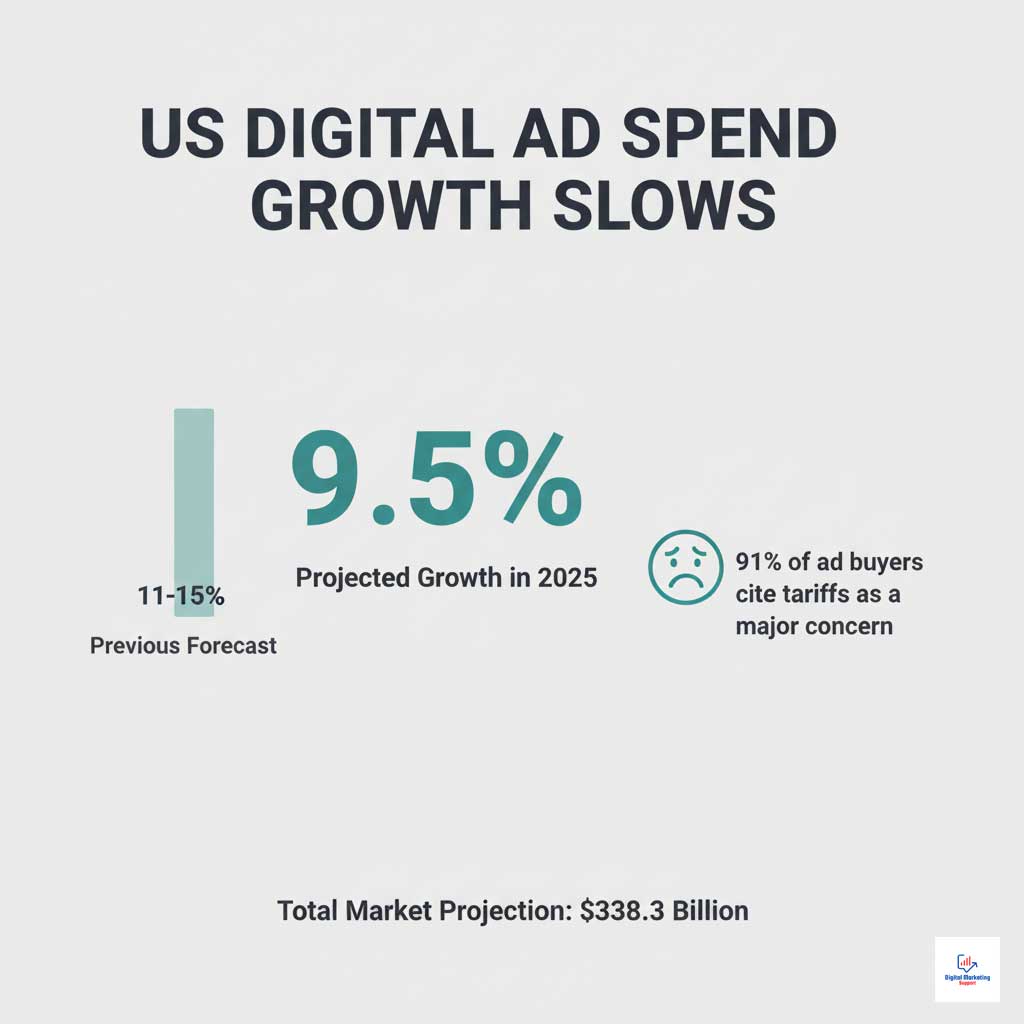
This slowdown isn’t a market crash but a strategic recalibration. Brands are not abandoning digital marketing; they are re-evaluating where to place their bets. The clear trend is a move away from high-cost, bottom-of-the-funnel paid search toward more cost-effective, brand-building channels, which reinforces the need for a robust digital marketing trends USA strategy focused on organic growth.
Industry Deep Dive: Auto and Retail Face the Brunt of Ad Cuts
The ad budget reduction is not spread evenly across the US digital economy. The hardest-hit sectors are those with heavy reliance on global supply chains.
The most dramatic example is the trend in auto retail digital ad cuts. The US automotive industry, which depends heavily on imported parts, has seen its projected digital ad spend growth for 2025 plummet to just 2.2%. This is a massive drop from the 11.1% growth expected previously, impacting a sector that was on track to spend $22.25 billion.
Similarly, the retail sector is bracing for a slowdown. While the retail ad spend forecast still shows growth to $92.6 billion, the rate has slowed to 7.4%. This is a direct consequence of tariffs on consumer goods, which force retailers to choose between absorbing costs (and cutting marketing) or raising prices (and risking a drop in demand).
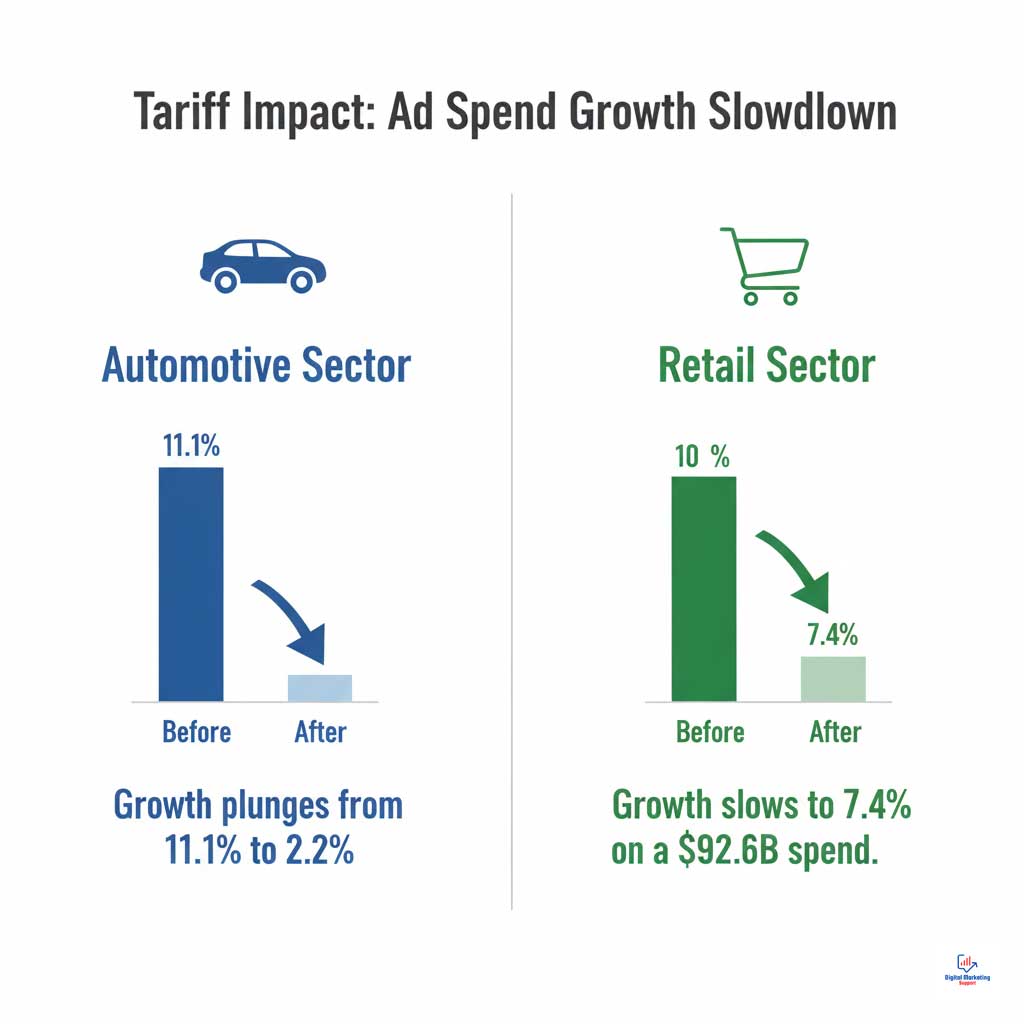
Case Study: The E-Commerce Reaction (Shein & Temu)
For a real-world example of the impact of tariffs on e-commerce advertising budgets, look no further than fast-fashion giants Shein and Temu. These companies built their empires on a U.S. trade rule known as the de minimis exemption, which allowed them to ship packages directly to consumers tax-free. When discussions arose about closing this loophole, both companies immediately paused their massive Google Shopping ad campaigns. This action demonstrates the direct, hair-trigger relationship between trade policy news and digital ad spend.
Strategic Comparison: Marketing Approaches Before and After Tariff Hikes
To thrive, marketers must evolve their entire strategic framework from a growth-at-all-costs mindset to one centered on efficiency, profitability, and long-term brand resilience. The table below outlines this critical shift.
| Marketing Pillar | Pre-Tariff Strategy (Growth-Focused) | Post-Tariff Strategy (Efficiency-Focused) |
| Primary Goal | Rapid customer acquisition & market share expansion. | Customer retention, profitability, and building long-term brand equity. |
| Budget Allocation | Heavily weighted toward PPC, social ads, and top-of-funnel campaigns. | Balanced, with a significant shift toward SEO, content marketing, and CRM. |
| Key Metrics (KPIs) | Customer Acquisition Cost (CAC), ROAS, Lead Volume. | Customer Lifetime Value (CLV), Organic Traffic Growth, Brand Recall, ROI. |
| Content Approach | Broad, high-volume campaigns targeting commercial-intent keywords. | Deep, authoritative content targeting informational, cost-conscious queries. |
| Technology Focus | Ad bidding platforms and analytics tools (e.g., Google Ads, FB Ads). | AI content tools, personalization engines, and SEO analytics platforms. |
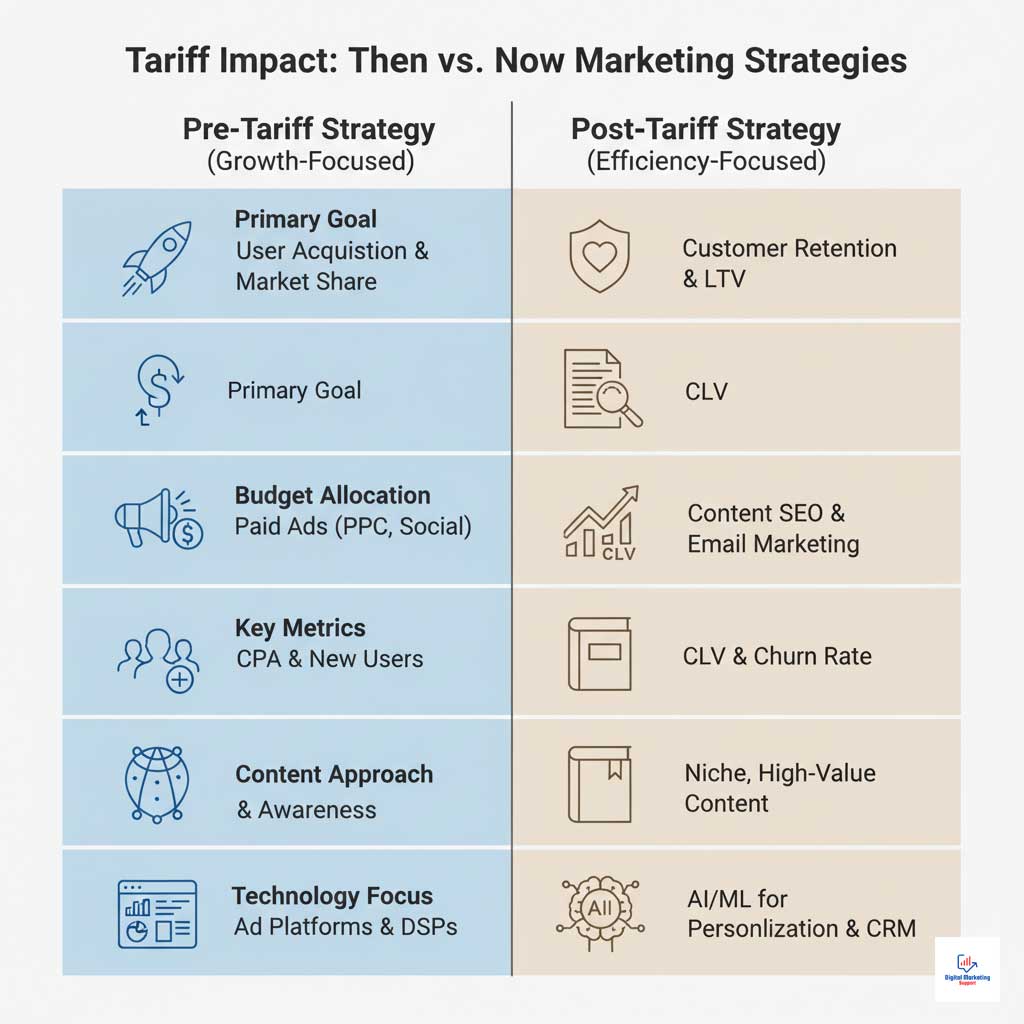
The SEO Pivot: Actionable Strategies to Win in a Volatile Market
Recognizing the problem is easy; implementing the solution is what separates the winners from the losers. An effective SEO strategy adaptation is more than just writing a few blog posts. It’s a fundamental reallocation of resources and a shift in mindset toward creating genuine value for your audience.
Reallocating Budgets: How to Shift from PPC to SEO Effectively
For many, the question is, how to shift PPC budgets to SEO during market uncertainty? It requires a disciplined, three-step approach:

- Audit and Consolidate: Conduct a granular audit of your current PPC campaigns. Identify underperforming ad groups, low-converting keywords, and campaigns with a marginal ROAS. Pause these immediately and reallocate that spend.
- Invest in Content Infrastructure: Reinvest the freed-up budget into your content engine. This could mean hiring skilled writers, investing in SEO tools like Ahrefs or Semrush, or commissioning expert-led research for cornerstone content.
- Build Topical Authority: Instead of chasing disparate keywords, focus on building deep topical authority around your core business areas. Create content clusters that answer every possible question a user might have, establishing your brand as the definitive resource. This is one of the most winning SEO tactics during economic downturns.
Content Strategy for a Post-Tariff World: Answering New Consumer Questions
Tariffs and inflation change behavior. Your content strategy after tariffs must reflect this by anticipating and answering the new questions running through your customers’ minds. The consumer search intent is shifting from “what to buy” to “how to buy smarter.”
Your content calendar should now include topics like:
- “Best [Product] Alternatives Made in the USA”
- “How to Make [Product] Last Longer”
- “Is [Brand Name] Affected by the New Tariffs?”
- “Cost-Saving Tips for [Industry] Enthusiasts”
By creating this type of value-driven, informational content, you attract a highly engaged audience and build trust that transcends price points.
The Power of Omnichannel: Creating Stability in an Unstable World
Over-reliance on a single channel is a recipe for disaster in a volatile market. An omnichannel marketing approach creates a resilient ecosystem where your channels support each other. Strong SEO drives organic traffic, which you can capture into an email list. That email list allows you to communicate directly with your audience, bypassing expensive ad platforms.
This is why creating integrated omnichannel campaigns post-tariff hikes is so crucial. A customer might discover you through an SEO-optimized blog post, follow you on social media for updates, and make a purchase after receiving a targeted email offer. This diversified approach ensures that a budget cut in one area doesn’t cripple your entire marketing operation.
The Marketer’s Tech Stack: Leveraging AI to Mitigate Tariff Fallout
Technology, particularly artificial intelligence, has become an indispensable ally for marketers navigating this complex landscape. The right tech stack can provide the insights and efficiency needed to make every dollar count, directly addressing the adtech economic impact of trade policies.
AI-Driven Personalization: The Antidote to Generic Messaging
When customers are price-sensitive, generic marketing messages fall flat. AI-driven personalization allows you to tailor your communication to each user’s specific context and concerns. With 75% of brands now adopting generative AI, this is rapidly becoming table stakes. The answer to the question, “Are AI tools helping marketers minimize tariff fallout?” is a definitive yes.
AI can help you communicate price increases with empathy, highlight the long-term value of your products, and offer personalized alternatives that fit a customer’s budget. This level of personalization builds brand loyalty that can withstand economic headwinds.
AI-Powered Market Intelligence and Content Creation
Beyond messaging, generative AI digital marketing tools are transforming how marketers conduct research and create content. AI platforms can analyze millions of data points to identify shifts in consumer sentiment and search behavior in real-time, allowing you to adapt your strategy on the fly.

Furthermore, they can accelerate the production of high-quality, SEO-optimized drafts, enabling your team to scale content creation and quickly build the topical authority needed to rank organically. This efficiency is critical when resources are tight. The table below breaks down how AI provides tangible ROI in a tariff-impacted market.
| Marketing Challenge from Tariffs | AI-Powered Solution | Example AI Tool(s) | How It Delivers ROI |
| Understanding New Consumer Search Intent | Real-time trend analysis & topic clustering. | Semrush, Ahrefs, MarketMuse | Identifies emerging keywords and questions to guide a relevant content strategy. |
| Scaling SEO Content Production | High-quality draft generation and content optimization. | Jasper, ChatGPT-4, SurferSEO | Reduces content creation time by 50-70%, allowing teams to build topical authority faster. |
| Communicating Price Changes Effectively | Predictive personalization and sentiment analysis. | Persado, Phrasee, Optimizely | Crafts empathetic, high-converting messaging that preserves brand trust and reduces churn. |
| Optimizing Reduced Ad Budgets | Predictive audience modeling and bid management. | HubSpot AI, Albert AI | Focuses ad spend on the highest-potential audience segments, maximizing ROAS. |
Summary & Key Takeaways: Building a Future-Proof Digital Marketing Strategy
The resurgence of protectionist trade policies has undeniably reshaped the digital marketing 2025 landscape. By constricting ad budgets and forcing a widespread re-evaluation of marketing priorities, these tariffs have catalyzed a necessary evolution in strategy. The brands that cling to old, ad-centric models will struggle, while those that embrace a more agile, organic-first approach will build a formidable competitive advantage.

Here are the key takeaways for building a future-proof strategy:
- Tariff Impacts Are Real: The impact of trade policy on marketing is direct and measurable, with the US ad spend 2025 forecast clearly showing a market slowdown.
- The Pivot to SEO is Essential: A strategic shift from renting visibility through paid media to owning it through SEO is the most effective defense against budget volatility.
- Consumer Intent is King: Success now hinges on deeply understanding and adapting to the new, more cost-conscious questions your customers are asking.
- Technology is Your Ally: AI and omnichannel strategies are no longer buzzwords but essential tools for achieving the efficiency and personalization needed to thrive.
While economic uncertainty presents undeniable challenges, it also creates clarity. It rewards the most agile, data-driven, and customer-centric marketers. The brands that invest in building genuine organic authority today are the ones that will own the market of tomorrow, regardless of the macroeconomic climate.
Frequently Asked Questions (FAQs)
How do Trump’s tariffs directly affect a digital marketer’s daily job?
Tariffs increase product costs, which leads to reduced marketing budgets. For a digital marketer, this means lower daily ad spend limits, pressure to achieve a higher ROAS, and the need to justify every dollar. It forces a shift from large-scale paid campaigns to more efficient channels like SEO and email marketing.
What is the first step in adapting our SEO strategy to economic downturns?
The first step is to conduct a deep analysis of consumer search intent. Use tools like Google Trends and your Search Console data to identify how user queries are changing. Are people searching more for “discounts,” “reviews,” or “alternatives”? This insight should guide your entire content strategy.
Are B2B marketing budgets as affected by tariffs as B2C budgets?
Yes, though sometimes indirectly. While B2C retail and auto are hit directly, B2B companies that sell to these industries will feel the impact as their clients cut spending. B2B marketers must also pivot, often focusing on high-ROI activities like webinars, partnership marketing, and creating authoritative content that generates organic leads.
Besides auto and retail, what other US industries are pulling back on digital ads?
Other affected industries include consumer electronics, home goods and furniture, and manufacturing sectors that rely on imported materials. Any industry with a significant dependency on the US-China tariffs effects is likely re-evaluating its ad spend.
How can we measure the ROI of shifting our budget from PPC to SEO?
Measure the ROI of SEO by tracking metrics like organic traffic growth, keyword ranking improvements for commercial terms, the number of organic leads or sales generated (via analytics goal tracking), and the overall Customer Lifetime Value (CLV) of an organically acquired customer versus a paid one.
What role does local SEO play in a marketing strategy impacted by supply chain tariffs?
Local SEO becomes critically important. As supply chain tariffs marketing disrupts the availability of foreign goods, consumers increasingly search for “local providers” and “products made in the USA.” Optimizing your Google Business Profile and creating location-specific content can capture this high-intent traffic.
Is it better to pause all paid advertising during high market volatility?
Not necessarily. It’s better to be strategic. Pause low-performing campaigns, but consider maintaining a smaller budget for high-intent, branded search campaigns where the ROAS is consistently high. The goal is efficiency, not complete elimination.
How do you build a business case for increased SEO funding when overall budgets are being cut?
Frame SEO as a long-term asset, not a short-term expense. Use data to show how organic traffic is more resilient and cost-effective over time. Project the future value of a top-ranking page and contrast it with the ever-increasing costs of paid clicks, highlighting the superior long-term ROI.
Can AI realistically replace human strategists in navigating these economic shifts?
No. AI is a powerful tool that enhances human strategy, but it cannot replace it. AI can analyze data and generate content at scale, but it requires human strategists to interpret the insights, understand brand nuance, and make the final creative and ethical decisions.
What is “hyper-personalization” in the context of tariff-related marketing?
It means moving beyond using a customer’s first name in an email. It’s about using data to understand their price sensitivity, their past purchases, and their current concerns to deliver a message that is uniquely relevant, such as offering a payment plan or suggesting a more affordable but similar product.
How long does it typically take for an SEO pivot to show tangible results?
While small improvements can be seen in 2-3 months, a significant SEO pivot typically takes 6-12 months to show substantial results in terms of traffic and lead generation. This is why it’s crucial to treat SEO as a long-term investment, not a quick fix.
Where can I find reliable data on digital ad spend forecasts and tariff impacts?
Reliable sources for this data include major industry research firms like eMarketer, Gartner, Forrester, and reports from industry bodies such as the Interactive Advertising Bureau (IAB). Business publications like The Wall Street Journal and Bloomberg also provide in-depth analysis of these trends.







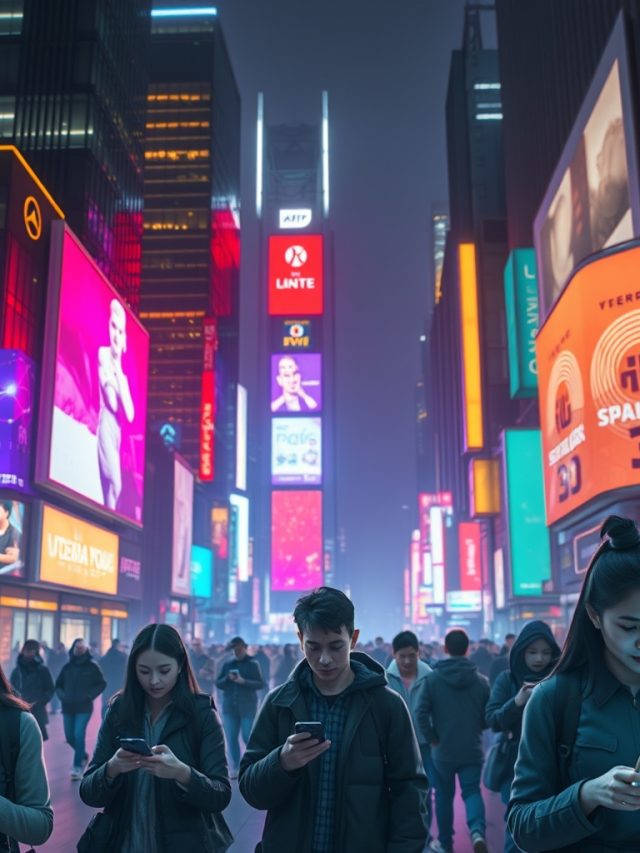


Good post! We will be linking to this particularly great post on our site. Keep up the great writing